Public relations capitalism
Investment conferences won’t revive Syria’s economy
November 2025
Damascus is courting investors with conferences, decrees, and billion-dollar memoranda. Reconstruction has become a public relations exercise in legitimacy and confidence-building. But most projects remain notional, shaped by politics than economics. What’s missing is a plan.
The fall of the Assad regime sparked hope among Syrians and internationals that Syria might overcome the impact of the war and move toward reconstruction. The new government in Damascus has built on this optimism by organising investment conferences and showy public announcements of reconstruction agreements worth billions of dollars. Whether any of it will translate into actual projects, and tangible improvements in living conditions, however, is anyone’s guess.
Where the money comes from
The government has declared that it will not depend on foreign aid or international loans, but instead on individual donations and, more importantly, direct investment. To support this strategy, the government has focused on improving the business environment and creating a more pro-investment legal framework. It has issued the Syrian Investment Law under Decree No. 114 of 2025 to facilitate the entry of foreign capital, revived the Syrian Investment Commission, pledged streamlined procedures and expanded public–private partnerships.
Over the summer the government signed dozens of agreements worth an estimated USD 32 billion. At first sight this figure is impressive; but it becomes less so on examination of how these agreements were signed, the nature of the proposed projects, the identity of the investors, and the projects’ likely impact on the lives of Syrians and the apparatus of the nascent state.
Most of these accords are memoranda of understanding (MoU), or general cooperation frameworks, rather than binding contracts. Such agreements are designed to show a willingness to consider investment: a public show of confidence in the government and, for the government, a source of legitimacy. This pattern of public relations-focused announcements echoes the experience of Egypt’s Sharm El-Sheikh Economic Conference of 2015, where investment pledges of nearly USD 92 billion were celebrated but only a handful translated into actual outlays.
Learning from neighbours
The MoUs and general cooperation frameworks mostly involve high-visibility, capital-intensive projects such as real estate and large-scale energy ventures. These generate limited employment opportunities, only minimally improve essential public services and, all too often, lead to much higher utility bills. Lessons abound from Syria’s neighbours. Lebanon’s post-war reconstruction attracted major investment but this was channeled into real estate and banking, leaving infrastructure and sustainable employment unaddressed. Iraq, despite investing billions of dollars in electricity after 2003, still faces chronic power shortages. Even when projects materialise, their developmental value depends on such matters as good governance and alignment with citizen needs, not only on investor returns.
Profiles of the investors involved shows, moreover, that these agreements are being shaped by regional alignments and elite bargaining rather than developmental impact.
The agreements signed so far largely neglect value-adding activities in manufacturing and agriculture. Over 90 per cent of Syria’s businesses are micro and small and medium enterprises (SMEs), and these could be boosted by enhanced access to finance, technology, and markets, and by integration into regional and international value chains. The limited number of industrial initiatives being discussed – cement production, for example – appear intended primarily to supply the real estate sector. The concentration of investments in the Damascus region meanwhile increases regional inequalities, at a cost, particularly, of areas most heavily damaged during the conflict.
Profiles of the investors involved shows, moreover, that these agreements are being shaped by regional alignments and elite bargaining rather than developmental impact. Investor vetting has been weak: several putative investors have signed large MoUs despite lacking proven financial capacity, operational history, or transparent ownership structures. Projects have frequently been awarded without competitive bidding, while the public remain ignorant of contract terms and project feasibility.
Need for a national strategy
What the plethora of investment MoUs and framework agreements really demonstrates is the absence of a national development strategy that prioritises the rule of law. Such a strategy would strengthen transparency – and hence public trust and investor confidence – through public disclosure of investment agreements and independent oversight. It would also entail decentralised investment governance mechanisms and an empowering of regional institutions in order to help direct capital according to professionally defined priorities, reduce elite concentration of wealth and discourage the emergence of new crony capitalists. Redirecting incentives toward productive sectors such as agri-food, textiles, and pharmaceuticals would significantly support employment and exports, while empowering SMEs would enhance long-term sustainability. Modernising labour and social protection laws would also ensure the workforce benefits from investment.
The government is right to seek to attract investors; but equally important is having an effective strategy for inclusive economic development that complements state rebuilding.
This analysis was provided exclusively by Syrian Ventures Alliance, an investment and economic advisory platform.
